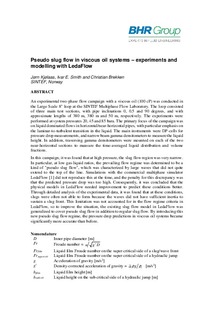| dc.description.abstract | An experimental two-phase flow campaign with a viscous oil (100 cP) was conducted in the Large Scale 8" loop at the SINTEF Multiphase Flow Laboratory. The loop consisted of three main test sections, with pipe inclinations 0, 0.5 and 90 degrees, and with approximate lengths of 380 m, 380 m and 50 m, respectively. The experiments were performed at system pressures 20, 45 and 85 bara. The primary focus of the campaign was on liquid dominated flows in horizontal/near-horizontal pipes, with particular emphasis on the laminar-to-turbulent transition in the liquid. The main instruments were DP-cells for pressure drop measurements, and narrow beam gamma densitometers to measure the liquid height. In addition, traversing gamma densitometers were mounted on each of the two near-horizontal sections to measure the time-averaged liquid distribution and volume fractions. In this campaign, it was found that at high pressure, the slug flow region was very narrow. In particular, at low gas-liquid ratios, the prevailing flow regime was determined to be a kind of "pseudo slug flow", which was characterized by large waves that did not quite extend to the top of the line. Simulations with the commercial multiphase simulator LedaFlow [1] did not reproduce this at the time, and the penalty for this discrepancy was that the predicted pressure drop was too high. Consequently, it was concluded that the physical models in LedaFlow needed improvement to predict these conditions better. Through detailed analysis of the experimental data, it was found that at these conditions, slugs were often not able to form because the waves did not have sufficient inertia to sustain a slug front. This limitation was not accounted for in the flow regime criteria in LedaFlow, so to improve the situation, the existing slug flow model in LedaFlow was generalized to cover pseudo slug flow in addition to regular slug flow. By introducing this new pseudo slug flow regime, the pressure drop predictions in viscous oil systems became significantly more accurate than before. | nb_NO |
